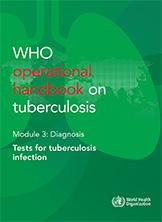1.4 About this operational handbook
This handbook reviews who should be tested for TB infection, and why and how they should be tested under programmatic settings. It provides information about the specific TB infection tests, from the original TST to the recently approved TBSTs, and the blood-based IGRAs, which are categorized as tests that measure interferon-gamma production using methods based on enzyme-linked immunosorbent assay (ELISA) or enzyme-linked immunosorbent spot (ELISPOT). Finally, programmatic aspects of the implementation and scale-up of TB infection testing are explained.
 Feedback
Feedback
